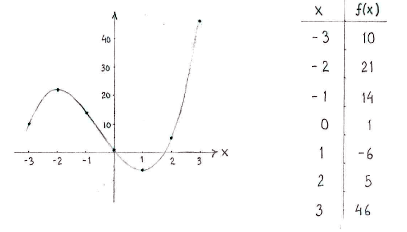Solution 1.3:2c
From Förberedande kurs i matematik 2
m |
|||
| (3 intermediate revisions not shown.) | |||
| Line 1: | Line 1: | ||
| - | + | There are three types of points at which the function can have local extreme points, | |
| - | + | ||
| - | + | ||
| - | + | ||
| - | + | ||
| - | + | ||
| - | + | ||
| - | + | ||
| - | + | ||
| - | [[ | + | # critical points, i.e. where <math>f^{\,\prime}(x)=0</math>, |
| + | # points where the function is not differentiable, and | ||
| + | # endpoints of the interval of definition. | ||
| + | |||
| + | Because our function is a polynomial, it is defined and differentiable everywhere, and therefore does not have any points which satisfy items 2 and 3. | ||
| + | |||
| + | As regards item 1, we set the derivative equal to zero and obtain the equation | ||
| + | |||
| + | {{Displayed math||<math>f^{\,\prime}(x) = 6x^2+6x-12 = 0\,\textrm{.}</math>}} | ||
| + | |||
| + | Dividing both sides by 6 and completing the square, we obtain | ||
| + | |||
| + | {{Displayed math||<math>\Bigl(x+\frac{1}{2}\Bigr)^2 - \Bigl(\frac{1}{2}\Bigr)^2 - 2 = 0\,\textrm{.}</math>}} | ||
| + | |||
| + | This gives us the equation | ||
| + | |||
| + | {{Displayed math||<math>\Bigl(x+\frac{1}{2}\Bigr)^2 = \frac{9}{4}</math>}} | ||
| + | |||
| + | and taking the square root gives the solutions | ||
| + | |||
| + | {{Displayed math||<math>\begin{align} | ||
| + | x &= -\frac{1}{2}-\sqrt{\frac{9}{4}} = -\frac{1}{2}-\frac{3}{2} = -2\,,\\[5pt] | ||
| + | x &= -\frac{1}{2}+\sqrt{\frac{9}{4}} = -\frac{1}{2}+\frac{3}{2} = 1\,\textrm{.} | ||
| + | \end{align}</math>}} | ||
| + | |||
| + | This means that if the function has several extreme points, they must be among | ||
| + | <math>x=-2</math> and <math>x=1</math>. | ||
| + | |||
| + | Then, we write down a sign table for the derivative, and read off the possible extreme points. | ||
| + | |||
| + | {| border="1" cellpadding="5" cellspacing="0" align="center" | ||
| + | |- | ||
| + | |width="50px" align="center" style="background:#efefef;"| <math>x</math> | ||
| + | |width="50px" align="center" style="background:#efefef;"| | ||
| + | |width="50px" align="center" style="background:#efefef;"| <math>-2</math> | ||
| + | |width="50px" align="center" style="background:#efefef;"| | ||
| + | |width="50px" align="center" style="background:#efefef;"| <math>1</math> | ||
| + | |width="50px" align="center" style="background:#efefef;"| | ||
| + | |- | ||
| + | |width="50px" align="center"| <math>f^{\,\prime}(x)</math> | ||
| + | |width="50px" align="center"| <math>+</math> | ||
| + | |width="50px" align="center"| <math>0</math> | ||
| + | |width="50px" align="center"| <math>-</math> | ||
| + | |width="50px" align="center"| <math>0</math> | ||
| + | |width="50px" align="center"| <math>+</math> | ||
| + | |- | ||
| + | |width="50px" align="center"| <math>f(x)</math> | ||
| + | |width="50px" align="center"| <math>\nearrow</math> | ||
| + | |width="50px" align="center"| <math>21</math> | ||
| + | |width="50px" align="center"| <math>\searrow</math> | ||
| + | |width="50px" align="center"| <math>-6</math> | ||
| + | |width="50px" align="center"| <math>\nearrow</math> | ||
| + | |} | ||
| + | |||
| + | |||
| + | The function has a local maximum at <math>x=-2</math> and a local minimum at <math>x=1</math>. | ||
| + | |||
| + | We obtain the overall appearance of the graph of the function from the table and by calculating the value of the function at a few points. | ||
| + | |||
| + | [[Image:1_3_2_c.gif|center]] | ||
Current revision
There are three types of points at which the function can have local extreme points,
- critical points, i.e. where \displaystyle f^{\,\prime}(x)=0,
- points where the function is not differentiable, and
- endpoints of the interval of definition.
Because our function is a polynomial, it is defined and differentiable everywhere, and therefore does not have any points which satisfy items 2 and 3.
As regards item 1, we set the derivative equal to zero and obtain the equation
| \displaystyle f^{\,\prime}(x) = 6x^2+6x-12 = 0\,\textrm{.} |
Dividing both sides by 6 and completing the square, we obtain
| \displaystyle \Bigl(x+\frac{1}{2}\Bigr)^2 - \Bigl(\frac{1}{2}\Bigr)^2 - 2 = 0\,\textrm{.} |
This gives us the equation
| \displaystyle \Bigl(x+\frac{1}{2}\Bigr)^2 = \frac{9}{4} |
and taking the square root gives the solutions
| \displaystyle \begin{align}
x &= -\frac{1}{2}-\sqrt{\frac{9}{4}} = -\frac{1}{2}-\frac{3}{2} = -2\,,\\[5pt] x &= -\frac{1}{2}+\sqrt{\frac{9}{4}} = -\frac{1}{2}+\frac{3}{2} = 1\,\textrm{.} \end{align} |
This means that if the function has several extreme points, they must be among \displaystyle x=-2 and \displaystyle x=1.
Then, we write down a sign table for the derivative, and read off the possible extreme points.
| \displaystyle x | \displaystyle -2 | \displaystyle 1 | |||
| \displaystyle f^{\,\prime}(x) | \displaystyle + | \displaystyle 0 | \displaystyle - | \displaystyle 0 | \displaystyle + |
| \displaystyle f(x) | \displaystyle \nearrow | \displaystyle 21 | \displaystyle \searrow | \displaystyle -6 | \displaystyle \nearrow |
The function has a local maximum at \displaystyle x=-2 and a local minimum at \displaystyle x=1.
We obtain the overall appearance of the graph of the function from the table and by calculating the value of the function at a few points.

